
Original Link: https://www.anandtech.com/show/2224
UPDATE: Thermalright Ultra-120 eXtreme - Retail
by Wesley Fink on May 4, 2007 3:00 AM EST- Posted in
- Cases/Cooling/PSUs
Almost two months ago the prototype for what became known as the Thermalright Ultra-120 eXtreme showed up on our doorstep. The review of the excellent Ultra-120 was just finished and that cooler moved to the top of our performance charts along with the Tuniq Tower 120 and some specialized configurations of a few other coolers.
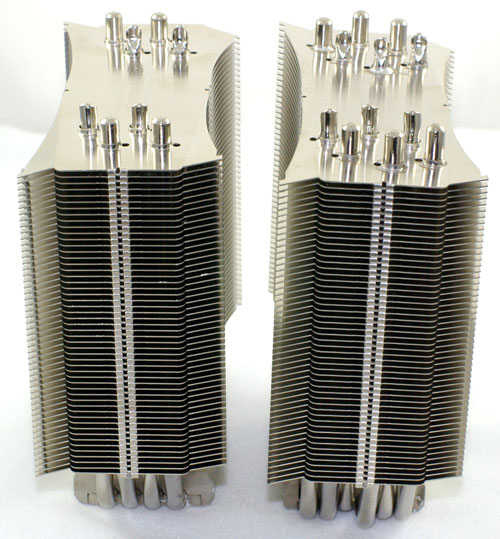
The eXtreme added two more heatpipes, for a total of six, but it was otherwise just like the Ultra-120 as far as we could tell. We didn't expect that much improvement over the already excellent Ultra-120, but many of you will recall that the prototype tested in the Thermalright Ultra-120 eXtreme preview set new records in air cooling. This was clearly the best air cooler ever tested in the AnandTech labs. The cooler prototype was not perfect, however. There was what we considered a major issue with the socket 775 mount, which needed to be bent to fit between the heatpipes and then straightened again. We suggested this needed to be fixed by Thermalright for the production version of the eXtreme.
It has been almost two months since our first look at the Thermalright Ultra-120 eXtreme, and the cooler is now in full production at Thermalright. You should start to see units for sale in the next few days. Thermalright advised us that they have fixed the issue with the socket 775 adapter. We were also advised that several minor refinements were made in the design of the eXtreme. Normally the availability of the production part would merely be a comment to another article or something for AnandTech Forum discussions. However, this cooler has generated a huge amount of interest simply because it performed better than any we have tested. For that reason, we felt we should take another look at the production unit, to make certain the mounting was corrected and to confirm the outstanding performance we first saw in the prototype.
Thermalright offered to ship us a retail production unit, so this is an update based on the production Ultra-120 eXtreme. We also retested the production unit to see if a second Thermalright Ultra-120 eXtreme - this one a retail unit - would perform just as well as the eXtreme prototype. We even tested with the same Scythe S-FLEX fan used in our first tests.
Coolers are less subject to production changes that degrade performance than motherboards are; we have at times found great prototype motherboards that proved less than stellar when finally in full production. For our readers, we felt a second test would confirm that the Thermalright Ultra-120 eXtreme you buy will deliver the same chart-topping performance than we found in testing at AnandTech, so today we are testing the retail production sample.
Ultra-120 eXtreme Production Kit
As we have said many times, Thermalright has never been one to invest in fancy packaging. The usual Thermalright cooler comes in a sturdy brown box, with at least the name nowadays. What's in the box is what really matters, and Thermalright has more often than not delivered some of the best coolers on the market.
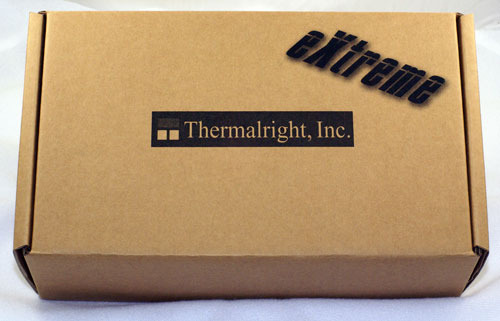
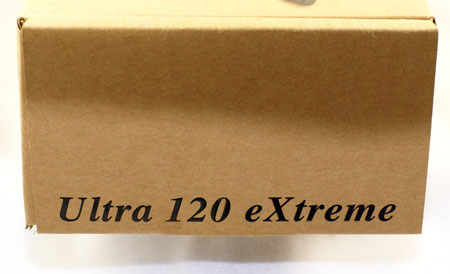
Thermalright is really proud of the Ultra-120 eXtreme, at least based on the final packaging. This is the first time Thermalright has used big 3-D Shadow print to announce the name.
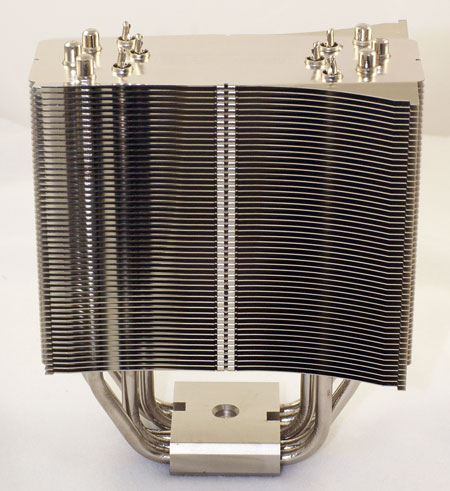
We looked closely, but we really couldn't find any difference in the prototype we tested and the retail eXtreme tower. Perhaps some sharp-eyed readers will find subtle improvements that found their way into the production eXtreme.
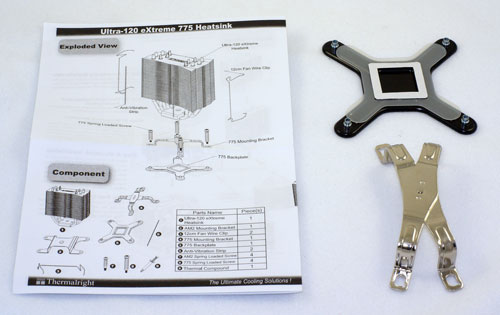
The AM2 plate is the same, but the socket 775 plate is a complete redesign. The original 775 mount would not fit between the extra pipes of the eXtreme. The revised 775 mount folds, and is easily passed through the tighter pipes on the eXtreme.
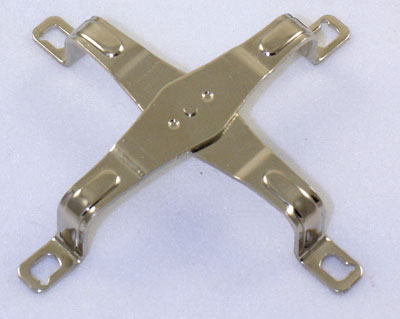
Once passed through the pipes, the 775 adapter is pushed open to align with the mounting holes. The back plate has also been slightly altered to allow better electrical isolation of the metal back plate. There are now elastomer pads on the motherboard contact surfaces.
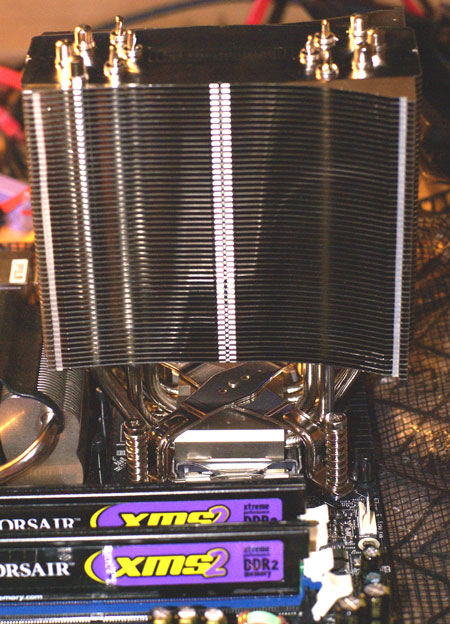
The new socket 775 adapter is certainly an improvement over the older design in terms of convenience, but we still have one complaint. The old adapter held the cooler firmly in place on socket 775, while the new adapter allows the cooler to be turned a bit after mounting, whether intentional or accidental. Buyers will be perfectly happy with the eXtreme's mounting and performance, but the 775 bracket could be improved further with wider metal on one of the blades that secures the cooler so it won't be able to turn. In this aspect the AM2 adapter is really sturdier, since the heatpipe tower is held rigidly in place on socket AM2 after mounting.
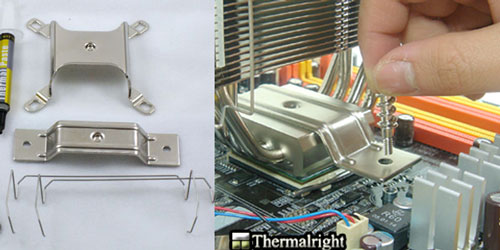
It is also important to understand that the Ultra-120 eXtreme comes with AM2 and socket 775 adapters. However, it does not ship with the AMD 754/939/940 adapter. There is a 754/939/940 adapter (K8) in the Ultra-120 kit. It will also fit the eXtreme so that it can be used on the slightly older AMD sockets. If you want to use the eXtreme on an AMD 754/939/940 processor you will need to ask Thermalright to sell you the Ultra-120 AMD K8 adapter, or talk your dealer or a U120-owning friend into helping you out.
Test Configuration
The test setup was exactly the same as used in the recent Thermalright Ultra-120 and Ultra-120 eXtreme preview. All the components of the test bench remained the same.
| Cooling Performance Test Configuration | |
| Processor | Intel Core 2 Duo X6800 (x2, 2.93GHz, 4MB Unified Cache) |
| RAM | 2x1GB Corsair Dominator PC2-8888 (DDR2-1111) |
| Hard Drive(s) | Hitachi 250GB SATA2 enabled (16MB Buffer) |
| Video Card | 1 x EVGA 7900GTX - All Standard Tests |
| Platform Drivers | NVIDIA 9.53 |
| NVIDIA nTune | 5.05.22.00 (1/16/2007) |
| Video Drivers | NVIDIA 93.71 |
| CPU Cooling | Thermalright Ultra-120 eXtreme Cooler Master Gemini II Noctua NF-U12F ASUS Silent Square Pro Scythe Ninja Plus Rev. B OCZ Vindicator Thermalright Ultra 120 Scythe Infinity Zalman CNS9700 Zalman CNS9500 CoolerMaster Hyper 6+ Vigor Monsoon II Lite Thermalright MST-9775 Scythe Katana Tuniq Tower 120 Intel Stock HSF for X6800 |
| Power Supply | OCZ PowerStream 520W |
| Motherboards | EVGA nForce 680i SLI (NVIDIA 680i) |
| Operating System | Windows XP Professional SP2 |
| BIOS | Award P24 (1/12/2007) |
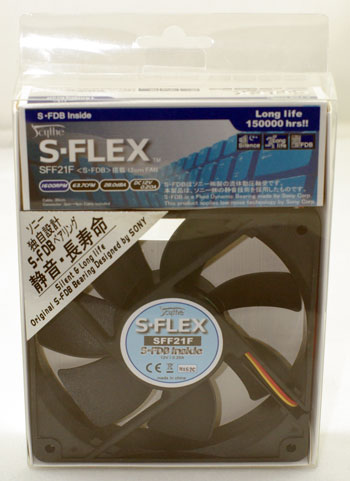
All cooling tests were run with the components mounted in a standard mid-tower case. The idle and stress temperature tests are run with the case closed and standing as it would in most home setups. We do not use auxiliary fans in the test cooling case, except for the Northbridge fan attached to the 680i for overclocking.
We tested with the same Scythe S-FLEX fan used in the Thermalright Ultra-120 review and the original Thermalright Ultra-120 eXtreme preview. This excellent fan moves a lot of air, but still keeps noise low with the Sony developed Fluid Dynamic Bearing on the fan motor. All testing was with a single fan, as in the earlier Thermalright reviews.
Scaling of Cooling Performance
Across stock speed and all overclocks the retail Thermalright Ultra-120 eXtreme produced temperatures either identical to the prototype review or within 1C of the previous test results. These are considered equivalent results and they verify that performance of the retail Thermalright Ultra-120 eXtreme is the same as we measured earlier.
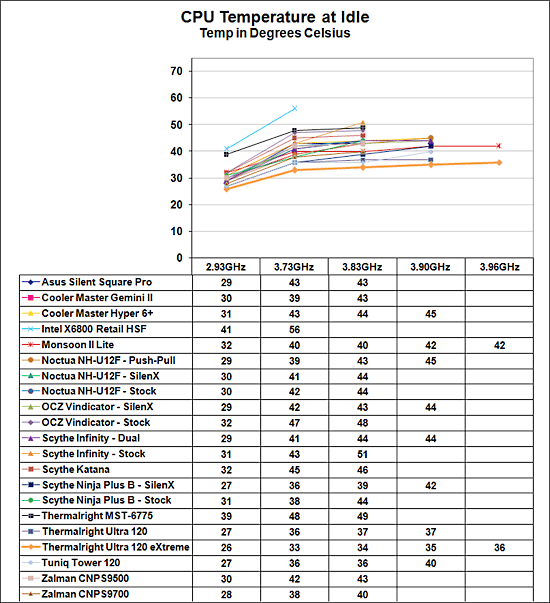 |
| Click to enlarge |
The Ultra-120 and Tuniq Tower 120 set some very high performance standards for effective cooling in overclocking. By 3.73GHz, the highest stable overclock with the Intel retail HSF, the temperature at idle was 56C. This compared to 36C with both the Ultra-120 and the Tuniq Tower 120. The extra heatpipes of the Ultra-120 eXtreme lower this to an even better 33C. By 3.90 GHz, the previous best overclock, the idle for the Tuniq is 40C and the Ultra-120 is 37C. The Thermalright Ultra-120 eXtreme drops the idle 2C lower to 35C, and is still at 36C at the highest stable overclock of 3.94GHz. This is very close to the performance level of the Monsoon II which uses active TEC cooling and not air alone.
Cooling efficiency of the Ultra-120 eXtreme under load conditions was the best tested so far by a wide margin. Compared to the Ultra-120, Tuniq Tower 120 and other recently top CPU coolers it is clear that the extra heatpipes in the Ultra-120 eXtreme are very effective in extending cooling performance.
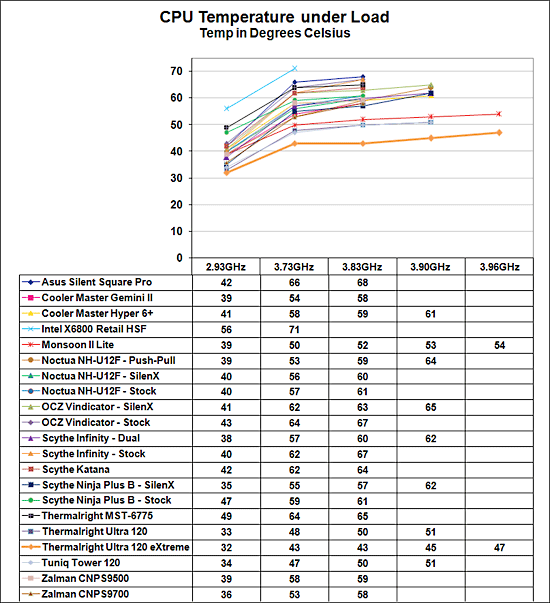 |
| Click to enlarge |
As you can see in the chart above the cooling efficiency of the Ultra-120 eXtreme under load is striking. Where the Tuniq Tower 120 and Ultra-120 mirror each other from 2.93GHz to 3.90GHz, the Thermalright Ultra-120 eXtreme creates a new performance curve at a lower temperature. The Tuniq and Ultra-120 are at 47/48 at 3.73GHz compared to the Intel retail at 71C. The Ultra-120 eXtreme shatters those cooling results by maintaining 43C.
The advantage increases even more as the overclock is raised. By 3.90 GHz, which is the highest overclock the Tuniq and Thermalright Ultra-120 could reach with stability, the Tuniq and Ultra-120 are both at 51C, which was the best performance among coolers tested so far. The Ultra-120 eXtreme, which is the same cooler as the Ultra-120 with just two additional heatpipes, bests both previous leaders by 6C with a 3.90GHz temperature of 45C.
Overclocking
The highest stable overclock we could achieve with the retail eXtreme was 3.93 GHz compared to the 3.94GHz achieved in the original review. Both results are higher than any achieved with any other cooler tested so far. We suspect this tiny difference is the result of either normal variation in test results, or even more likely the 2C higher ambient temperature in our test room compared to the room temperature in the initial review.
Our Take
In revisiting the Thermalright Ultra-120 eXtreme we had the opportunity to compare performance results from a retail eXtreme to those we found in our initial review of the Ultra-120 eXtreme. We are very pleased to report that the retail Ultra-120 eXtreme performed in every way just like the prototype we tested.
The Thermalright Ultra-120 eXtreme is the best cooler tested so far at AnandTech. Our complaints with the prototype about the poor socket 775 adapter have also been addressed in the production cooler. The revised adapter makes mounting an eXtreme on a Core 2 Duo an easy task now.
However, we do wish Thermalright could make the socket 775 adapter just as rigid and secure as the current AM2 adapter for the eXtreme. Performance certainly didn't suffer with the new bracket, but it is always an uneasy feeling when you find you can still turn a mounted cooler, as you can with the eXtreme with the new bracket. A little more metal on the folding cross bars could make the 775 install just as secure as the AM2. Another alternative might be slightly repositioning the bends on the adapter for secure nesting with the cooler CPU base plate.
That is a small thing when you consider the larger picture, which is a cooler that performs better than any of the 21 heatpipe towers recently tested at AnandTech. The eXtreme cools better than anything else we have tested. It was also nice to be reminded in this test of how small the Ultra-120 eXtreme really is compared to most other tower coolers. It is just as wide, but the eXtreme is compact in thickness, and you can actually mount the cooler on a socket 775 from above, without having to perform contortions better suited to a gymnast just to mount the cooler.
The Thermalright mounts easily without the fan, and if you use a prop like a foam block on the bottom to hold the plate while screwing in the spring-loaded screws, you can mount the cooler by just unscrewing the board in your case, and leaving all the peripherals attached. The back plate has screw posts that extend through the motherboard and the thinner depth means you can actually reach the spring mounting screws with the cooler installed. We also found it easiest to install the fan wires before screwing the cooler down, so you're ready to pop in the fan as the final step.
We have quite a collection of 120mm fans at AnandTech these days, but we tested with the same Scythe S-FLEX fan used in the original tests. The SFF21F is still a nice balance of airflow and noise and it matches the Thermalright Ultra-120 eXtreme very well. We will test other fans with this cooler in our fan roundup, but until we have other hard evidence there are better fan solutions out there you certainly won't be disappointed with a Scythe S-FLEX on the eXtreme.
It is always a pleasure when reviewing a product turns into collaboration. The reviewers at AnandTech are first and foremost computer enthusiasts just like you are. We normally try to point out grave errors to manufacturers, and we try to mention smaller things that might be improved in our reviews of their products. When a manufacturer pays attention and makes corrections to a product it is clearly evidence they care about the users of their products. Thermalright corrected a problem socket 775 adapter before production, and contacted us with a final retail sample. That is one example of the attention to detail that is in the best interest of buyers.
Online prices of the Thermalright Ultra-120 eXtreme look to start at around $55 plus shipping, which is about $10 more than the standard Thermalright Ultra-120. Add to that the cost of a reasonable fan (unless you're going for silence and want to run fanless) and the total price with shipping is likely to be $70-$75. In contrast, the Tuniq Tower 120 will cost around $55 with the included fan, plus shipping. While spending 20% more relative to the Tuniq Tower might not seem like the best return on investment, for those looking to maximize system performance and reduce temperatures we feel the extra $10 is money well spent. Besides, when viewed as part of a typical enthusiast system, that $10 is probably less than a 1% increase in cost for a drop in CPU temperatures of up to 6C.







